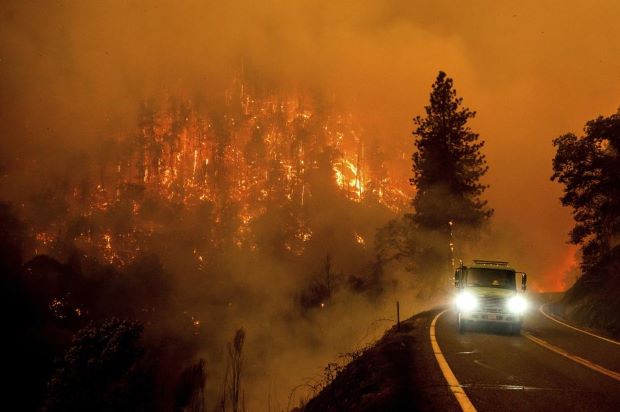McKinney fire becomes California’s largest of 2022, burning 51,000 acres
By Eduardo Medina
CALIFORNIA – A fast-growing wildfire fuelled by strong winds from thunderstorms and high temperatures in Northern California has grown to more than 51,000 acres in two days, becoming the state’s largest wildfire so far this year and forcing evacuations in rural neighbourhoods.
The blaze, named the McKinney fire, began burning through dry timber Friday (July 29) in the Klamath National Forest in Siskiyou County, California, near the Oregon state line, authorities said.
Officials had not reported any injuries or deaths associated with the fire as of Sunday (July 31) morning. Gov. Gavin Newsom of California declared a state of emergency for Siskiyou County on Saturday, saying nearly 2,000 people were under immediate evacuation orders. An additional 1,000 people have since been placed under evacuation orders, said Courtney Kreider, a spokesperson with the Siskiyou County Sheriff’s Office.
By Sunday morning, the fire had not moved much closer to the city of Yreka, which has a population of about 7,800. But it had already destroyed more than 100 structures — including homes, a grocery store and a community centre — in the surrounding area, Kreider said.
Joel Brumm, a spokesperson for Klamath National Forest said a fuller assessment of the damage remained pending. “We know that some structures have been lost but we don’t have any idea how many or the severity of the damage,” he said.
The heat from the fire generated a huge cloud called a pyrocumulonimbus, which has been referred to as “the fire-breathing dragon of clouds”, that essentially generated its own weather and reached more than 39,000 feet into the sky, according to the National Weather Service in Medford, Oregon.
“The fire created thunderstorms, which could have caused new fires nearby,” Brad Schaaf, a meteorologist with the weather service in Medford, said by phone Sunday.
The fire, which was 0% contained as of Sunday morning, is one of more than 50 large wildfires and fire complexes that have burned across parts of the United States so far this year, according to the National Interagency Fire Centre. In the foothills of the Sierra Nevada in California, the Oak fire has burned more than 19,000 acres and threatened thousands of homes and businesses. That fire was about 64% contained Sunday.
The McKinney fire comes at a precarious moment for the state, which, along with the Pacific Northwest, is facing abnormally high temperatures this week as a heat wave blankets the region.
Days of scorching temperatures and drought conditions have contributed to the intensity of fires by making vegetation drier and more likely to ignite. Analyses have shown that human-caused climate change has increased the likelihood of such extreme heat waves.
On Saturday (July 30), firefighters shifted their focus from battling the perimeter of the fire to helping residents evacuate and protecting structures, according to the US Forest Service.
Videos and photos of the fire showed wisps of smoke spiralling up from trees as flames covered the Klamath National Forest with an orange glow. Cars fled on nearly empty roadways, and officers with the Redding Police Department helped residents evacuate as they watched the forest burn in the distance.
“Heads up to those in the far north state,” the state’s Office of Emergency Services said on Twitter on Saturday. “The #McKinneyFire is moving quickly and aggressively driven by weather conditions.”
Three additional fires in the county — the China 2, Evans and Kelsey Creek fires — have merged and burned about 115 acres, Kreider said. The Kelsey Creek fire was caused by a lightning strike overnight, she added.
Officials and meteorologists were worried Sunday about possible thunderstorms that could develop through Tuesday evening. Schaaf said such thunderstorms could create more fires in the area if lighting struck.
Smoke from the McKinney fire, however, could lower temperatures and “counteract some of those thunderstorm ingredients,” he added.
Still, the Klamath National Forest said in a statement Sunday that “these conditions can be extremely dangerous for firefighters” as erratic winds push the fire in random directions.
“It makes for a challenging and complex forecast,” Schaaf said.
-New York Times


